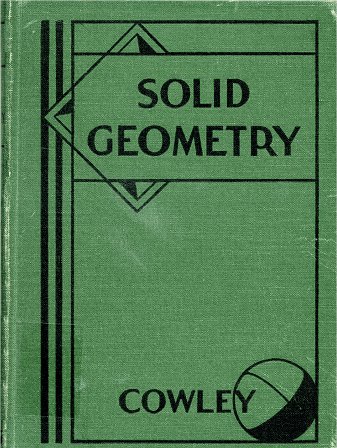Elizabeth Buchanan Cowley
Solid Geometry
Silver, Burdett and Company, 1934
 Preface
Preface
In this text solid geometry is so presented that the student will gain (1) a knowledge of the properties of planes and lines in space; of polyhedrons, cones, cylinders, and spheres; (2) further practice in the processes of logic which were begun in plane geometry; (3) a realization that he must understand solid geometry if he wishes to comprehend nature and art and the fascinating and diversified developments of modern means of communication, transportation, construction, and fabrication; and (4) skills and attitudes that will be helpful as a part of the training essential in meeting his own personal problems of everyday living.
As examples of these attitudes the following are cited: (1) geometry is a science of necessary conclusions; (2) it wrestles with difficult problems; (3) it tolerates no guessing or jumping at conclusions; and (4) it requires strict attention to the whole problem with discriminating use of the means at hand to obtain a solution.
In this text the student's attention is directed repeatedly to the relations of solid geometry to other school subjects, such as algebra, trigonometry, geography, and physics. The functional relations of geometric quantities are emphasized, thus tying up solid geometry with modern scientific thinking. Relations of solid geometry to various phases of modern life outside the classroom are also dealt with in exercises. Attention should be directed especially to the problems which contain data of actual work of present-day steel fabrication, refractories, and public utilities.
ContentsINTRODUCTION
BOOK VI. LINES AND PLANES IN SPACE
Lines Parallel or Perpendicular to a Plane
Parallel Planes
Dihedral Angles
Locus and Projection
Polyhedral Angles
BOOK VII. POLYHEDRONS, CYLINDERS, AND CONES
Prisms
Pyramids
General Polyhedrons
Cylinders
Cones
BOOK VIII. THE SPHERE
Circles of a Sphere
Tangents
Area and Volume of a Sphere
Spherical Triangles and Polygons
Useful Reference Material
Alternative Proofs
Helpful Material for Teachers
